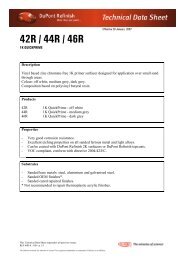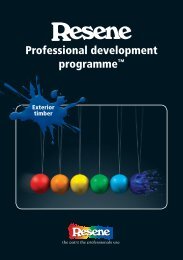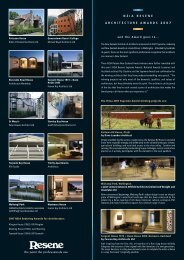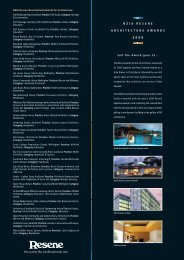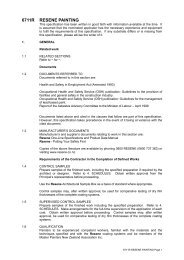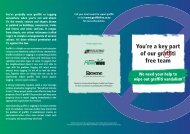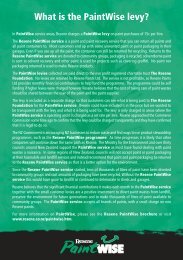Pedestrian Slip Resistance Testing to AS/NZS 3661.1 ... - Resene
Pedestrian Slip Resistance Testing to AS/NZS 3661.1 ... - Resene
Pedestrian Slip Resistance Testing to AS/NZS 3661.1 ... - Resene
You also want an ePaper? Increase the reach of your titles
YUMPU automatically turns print PDFs into web optimized ePapers that Google loves.
Central Labora<strong>to</strong>ries Report 04-527918.82-.83<br />
The results described within this test report are for the materials submitted by the client for testing.<br />
Users of this test reports should determine the extent <strong>to</strong> which the submitted materials are<br />
representative of the batch or variations from batch <strong>to</strong> batch from the supplier’s quality assurance<br />
procedures.<br />
Note that fac<strong>to</strong>rs such as wear, contamination or cleaning procedures may alter the surface<br />
properties and consequently the slip resistance of these materials.<br />
<strong>AS</strong> <strong>3661.1</strong> notes that the pendulum test is less reliable on highly profiled surfaces. This arises in<br />
part because the pendulum test needs <strong>to</strong> be set <strong>to</strong> have a contact path length of 123 – 127 mm. On<br />
the profiled tiles however the spacing of the profile can lead <strong>to</strong> slightly shorter of longer than<br />
specified path, or an abrupt contact by the slider contacting the edge of the highly profiled points.<br />
3 FRICTION REQUIREMENTS OF SURFACES<br />
Friction requirements of surfaces as defined in <strong>AS</strong>/<strong>NZS</strong> <strong>3661.1</strong> are:<br />
Coefficient of Friction – Wet: When tested in accordance with the method set out in Appendix A,<br />
the pedestrian surface shall have a mean coefficient of friction of not less than 0.4 and no specimen<br />
in that sample shall be less than 0.35.<br />
Coefficient of Friction – Dry: When tested in accordance with the method set out in Appendix B,<br />
the pedestrian surface shall have a mean coefficient of friction of not less than 0.4 and no specimen<br />
in that sample shall be less than 0.35.<br />
Note: It would generally be expected that surfaces that have been shown <strong>to</strong> comply with the wet<br />
requirement would also comply with the dry requirement.<br />
Ramps and Other Sloped Areas<br />
For all sloped or graded surfaces with a gradient not less than 2%, the minimum required value for<br />
the coefficient of friction of either wet or dry surfaces as specified above shall be increased in<br />
accordance with the following equation, expressed <strong>to</strong> an accuracy of 0.01:<br />
µ<br />
m<br />
=<br />
100µ + M<br />
100 − Mµ<br />
where µ m = coefficient of friction required for a sloped surface<br />
µ = coefficient of friction obtained on a horizontal surface<br />
M = maximum gradient of slope, in percent<br />
c:\resene\opus\04-527918.82-.83.doc<br />
2





